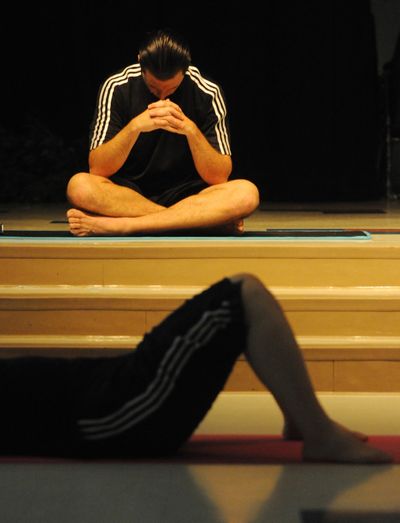Yoga sheds Hindu roots to attract Christian faithful
Christian yoga combines ancient exercise with devotional prayer and meditation

Chakras. The “third eye.” Sanskrit chanting. “Om.”
These staples of many yoga classes are a turnoff to some Christians.
But a Florida class combining yoga and Pilates with Christian prayer and meditation steers clear of yoga’s Hindu roots and seeks to show that Christian faith is compatible with the ancient form of movement and relaxation.
The class, called Praisemoves, is sponsored by Community of Hope, a non-denominational evangelical church in Loxahatchee, Fla.
It begins with a prayer thanking the Lord for bringing the group together. Participants proceed through a series of Sun Salutations, strength and balance poses, twists and Pilates exercises.
The class ends with meditation on a New Testament passage, such as 2 Corinthians 12:9: “And he said unto me, ‘My grace is sufficient for thee: for my strength is made perfect in weakness. Most gladly therefore will I rather glory in my infirmities, that the power of Christ may rest upon me.’ ”
“I have had Christians question if this is OK,” says Kerri Verna, who teaches the free class with her husband, Nick. “But yoga is not what it was 20 years ago. It used to be a form of religion; now it’s evolved to just a form of exercise.”
Still, such classes have their critics, who believe Christians should not do yoga under any circumstances.
The debate rages as an estimated 15.8 million Americans, or about 7 percent of the population, say they practice yoga and an additional 8 percent say they are interested in it, according to a 2008 Yoga Journal survey.
“You can’t take yoga out of its historical context and neuter it,” says Elliot Miller, editor in chief of Christian Research Journal, a publication of the Christian Research Institute in Charlotte, N.C.
“It’s a spiritual discipline for an Eastern religion,” he says. “It’s important for Christians not to put themselves in that world.”
A key difference between Christianity and Hinduism is their approaches to God, Miller says. Christians believe human beings can have a personal relationship with God and see death as a consequence of sin, trusting in Jesus for their salvation.
But in the Hindu view, human beings are not born sinners and can transcend the cycle of birth and death through an assortment of paths, with help from the many deities that help Hindus visualize and meditate. Hinduism sees yoga as a means to transcend the ego and achieve unity with God.
About half of American yoga students practice the poses to improve their health, according to the Yoga Journal study. They are not practicing true yoga, which is an all-consuming spiritual path, says Robert Bowman, director of research for the Institute for Religious Research, a Christian organization that studies religious claims.
“The concern I have as a Christian is for many people this is Hinduism-lite, an entree into alternative spiritualities that are packaged in a way that is not overtly religious,” he says.
Despite the controversy, the Christian yoga movement seems to be thriving, with books, videos and websites, such as ChristiansPracticingYoga. com, defending the practice and linking students with teachers across the country.
Steve Feinzig, owner of Yoga One, a nonsectarian yoga studio in Hollywood, Fla., says some visitors to his classes have been offended when the assembled chant “Om,” an affirmation of the divine similar to “Amen” for Jews and Christians.
Feinzig says his teachings focus on connecting practitioners with a “supreme consciousness,” a force that unifies human beings, and believes such references are welcoming to people of all faiths.
“I rarely use the word ‘God,’ ” Feinzig says. “Yoga is not a religion, but some people interpret it as such.”
Monica Schmidt, owner of American Yoga in Deerfield Beach, Fla., says Christian and Orthodox Jewish students in her classes have made it clear they want nothing more than physical conditioning.
“It’s OK to do it for exercise and call it a yoga workout,” Schmidt says. “The evolution of yoga is such that it has become a lifestyle, and we can extract things from it that everyone can benefit from.”
Community of Hope’s Praisemoves is attracting people to yoga who say they never would have tried it otherwise.
The class is not connected to PraiseMoves, a “Christian alternative to yoga” series of DVDs and books that connect postures and stretches with New Testament verses.
Jennifer Langley, 29, a Community of Hope congregant, says she thought yoga’s focus on breathing and chakras, or energy centers, was “weird” until she started the Community of Hope class.
“It was so not what I expected yoga to be like,” she says. “I had always done aerobics and running as my exercise. It was so much more relaxing to exercise this way.”
Lindy Chase, 48, also a congregant, says she would be uncomfortable chanting and hearing unfamiliar terms in a secular yoga studio.
Praisemoves, she says, is “a chance to think about God during the week in a wonderful, quiet setting.”